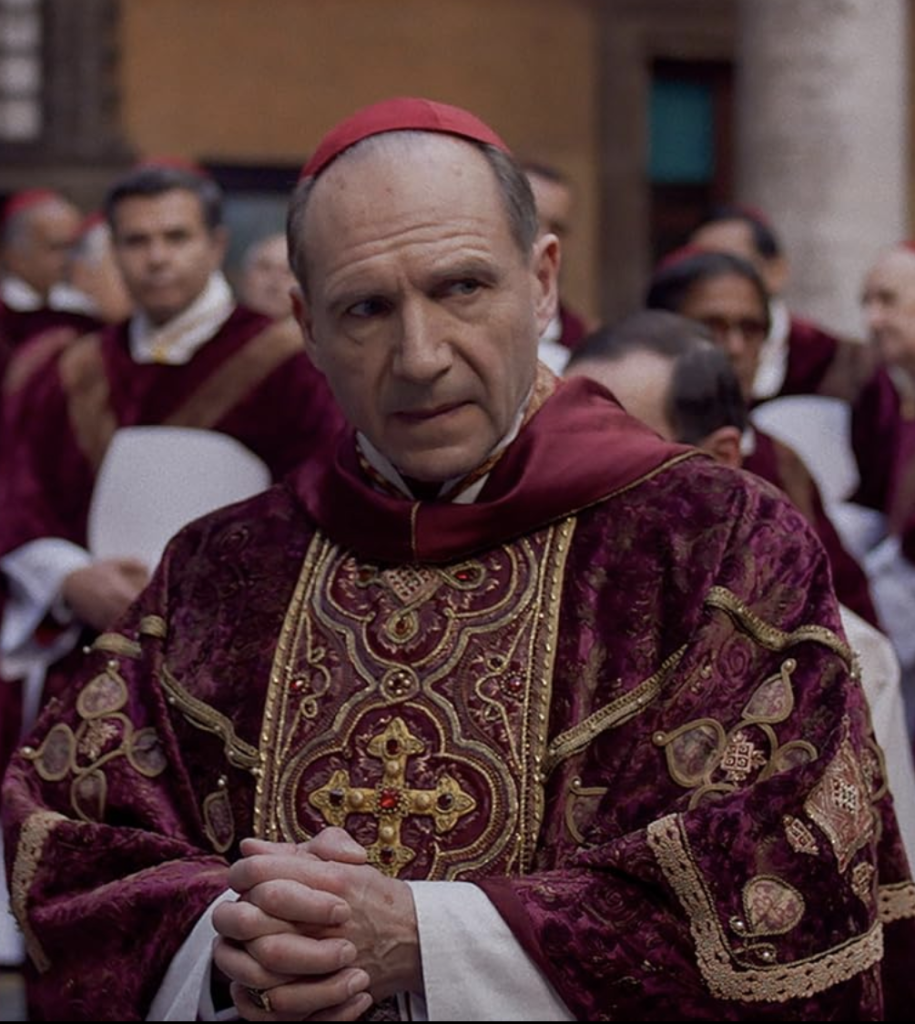
Review by Brad Balfour
Film: “Conclave”
Director: Edgar Berger
Cast: Ralph Fiennes, Stanley Tucci, John Lithgow, Sergio Castellitto, Isabella Rossellini
Unless you’re deeply insinuated in the many arcane ways and means of the Roman Catholic Church, appointing a new Pope is easily one of the most intricate, complex and secretive processes that this world-spanning religious institution has embraced.
How the succession of a human-born, spiritually-infused leader of the church’s 1.39 billion members/believers takes place is difficult enough to understand — even if you’re an ardent insider. But for the many who stand outside the church, it really seems convoluted. The recently released film “Conclave” does a little bit to lift the veil on the mystery once it’s in play and dispel some of the confusion.
Oscar-winning director Edgar Berger (“All Quiet on The Western Front”) finds the drama –– maybe even the melodrama –– in what seems to be a dry and tedious process. The beliefs of the recently deceased Pope in this film fell somewhere between the regressive/conservative faction of the cardinals who will vote for his successor and the liberal/progressive wing which represents the modern church’s efforts to bring the institution into the 21st century.
Managing this state of affairs is the College of Cardinals’ dean, Thomas Lawrence. Masterfully played by British actor Ralph Fiennes, Lawrence wrestles with his own ambitions and those of his allies and enemies among the Cardinals. Sharing similar convictions with Cardinal Bellini (Stanley Tucci), they discuss the dire consequences if the serious candidates are conservative hardliners like the oppressive-regressive Cardinal Tedesco (Sergio Castellitto, “Mafia Inc”) and the questionable Cardinal Tremblay (John Lithgow). There’s also a dark horse candidate, Cardinal Benitez (Carlos Diehz), whose existence was a mystery until the start of the conclave. Reasons for the mystery are made clear later but won’t be stated here because that would blow the big reveal at the movie’s end.
“Conclave” focuses on locked-room mysteries and insidious conspiracies. The German-based Berger’s approach highlights how much of a drama these proceedings can be, drawing in audiences while tricking them into thinking the production includes more than it actually does. There’s a lot on the line, but “Conclave” only offhandedly refers to the many vital issues currently facing the church such as sex crimes, thievery and abuses of power. The Sister Agnes character (Isabella Rossellini) provides a fulcrum on which to balance testosterone-infused male machinations.
While the church’s views on homosexuality and abortion are certainly on the line, the movie never really discusses these major black marks on the institution. The film is more about the blurred lines between spirituality and a hunger for power. While Lawrence is caught in the middle, he reluctantly concedes even that he’s considered a candidate — something he ultimately rejects. In one sense, that aversion to Popedom seems hollow since he has risen to such a powerful post which allows him to make decisions that only such a power-endowed individual can exercise.
Nonetheless, Berger — basing the film on Robert Harris’ 2016 book of the same name — highlights Lawrence’s internal conundrums. By trusting such a fine actor as Fiennes to express these conflicts without overtly voicing them, the emotional traumas are finely illuminated. As the film proceeds, various revelations about the process are also spotlighted making this film a rare look into a very secretive process.
“Conclave” sometimes works as an allegory for modern secular politics. But it often falls back on matters of spirituality, sometimes heavy-handedly. For a story about Catholicism –– a religion not exactly known for its subtle moralizing but, rather, for its many stark contradictions — the film offers some crucial insights. This isn’t a mere propagandistic exercise. In fact, given the human foibles outlined in this fascinating feature, it hardly provides a case for conversion.
